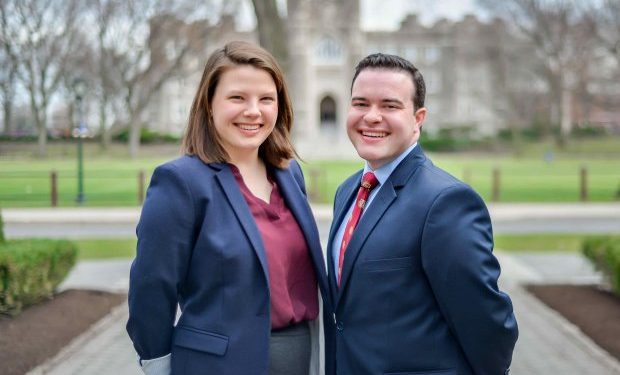By Theresa Schliep
Brian Reardon and Abigail Kedik won executive president and vice president, respectively, of United Student Government (USG) for the 2017-18 academic year. This year’s race saw a historic number of votes cast, as 1,131 voted for the Reardon/Kedik ticket, while 633 voted for their opposing ticket, Adam Hamilton and Eric Chacon.
Reardon said he thanks the student body for making this such a participatory election, as well as the Hamilton and Chacon campaign “on a hard fought election” and for making USG more visible to the student body.
“Their strategy of one-to-one campaigning brought out a lot of voters and made the USG visible,” said Reardon. “Both tickets worked very hard and we hope to carry that momentum into the fall as Abigail and work diligently to represent all students. I am thankful and humbled for all the support we received, and I am eager to start making a better Fordham.”
Kedick said she and Reardon are excited to stand by their campaign promises.
“We would like to thank everyone who made their voice heard in this year’s USG election,” said Kedik. Regardless of who you voted for, we stand by our promise to advocate for all students, and can’t wait to get to work.”
Hamilton said him and Chacon “congratulate Abigail and Brian on winning and know that they will do a great job next year and we wish them the best of luck.”
Of the eight vice president positions, two were contested. John Kuyat, FCRH ’19, was elected vice president of Fordham College at Rose Hill with 652 votes. Patrick Fox, FCRH ’20, was his opponent and had 321 votes. Amanda D’Antone won vice president of the Gabelli School of Business with 300 votes.
The debate, moderated by Erin Shanahan, FCRH ’18, editor in chief of The Fordham Ram, covered topics including the feeling of restriction of free speech on campus, the gap between residents and commuters and USG visibility.
Reardon and Kedik’s platform focused on bettering relations between USG and students. “Our overarching goal is to promote the betterment of students, especially those whose voices are often lost as we aim to bridge the gap improving students and USG,” said Reardon. Kedik elaborated on these gaps. “Gaps between students and administration, CSS, CSA, RHA and having USG be a larger presence within these communities,” said Kedik.
Hamilton and Chacon’s platform centered on USG being an advocate for students. “What should USG be? A student advocate above all else,” said Hamilton. Hamilton and Chacon said that outreach, working with commuters and pushing for substantial change within the guest policy were the leading goals of their platform. They also advocated for greater interaction between USG senators and clubs, planning to mandate senators attend club meetings as well as setting up a 24-hour communication service in place of traditional office hours.
“Our biggest and most important push will be to fight for change with the guest policy,” said Chacon.
Kedik and Reardon discussed their plan to help clubs facilitate free speech on campus through transparency of administration and greater discussion of free speech between USG and administrators in response to the first debate topic.
“It is imperative for students to fight for their student voice. Our job is to take this fight to the administration,” said Reardon.
Hamilton and Chacon highlighted their work with freedom of speech organizations on campus, and advocated that Jesuit identity and values should remain important to the university, but “shouldn’t extend to the student body.”
Regarding the commuter issue, Hamilton and Chacon responded saying it was a personal issue for them, as both were commuters for a time in their Fordham careers. They cited the lack of study space for commuters, amendments to the guest policy and earlier club times as necessary changes. Kedik said that she and Reardon had already met with CSA and CSS, and had plans for greater interactions between commuters and residents during new student orientation.
For the coming academic year, Reardon’s platform focuses on standing with the students. “We’re looking at where students are standing and standing with them there, seeing what they need and what we can provide them with,” said Reardon.





